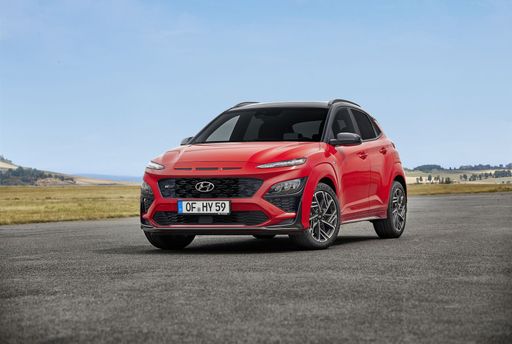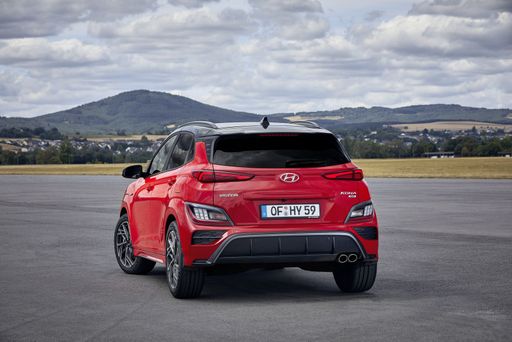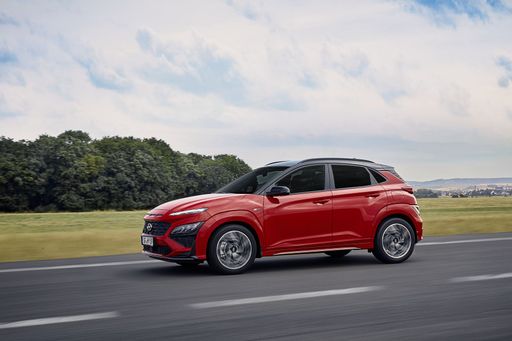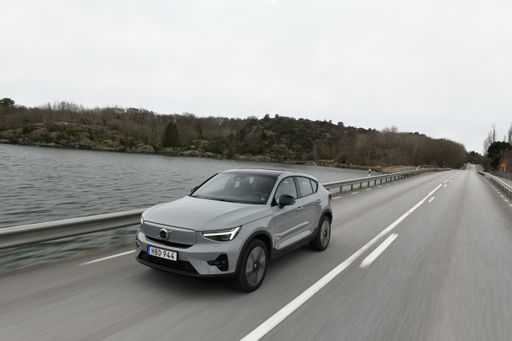Hyundai Kona vs Volvo EC40 – Performance, range & efficiency compared
Both models have their strengths – but which one suits you more?
Compare performance, efficiency, price and space directly: Hyundai Kona or Volvo EC40?
Here’s where it gets real: The technical differences in detail
Costs and Efficiency: When it comes to price and running costs, the biggest differences usually appear. This is often where you see which car fits your budget better in the long run.
Hyundai Kona has a strongly advantage in terms of price – it starts at 23100 £, while the Volvo EC40 costs 46600 £. That’s a price difference of around 23563 £.
In terms of energy consumption, the advantage goes to the Hyundai Kona: with 14.60 kWh per 100 km, it’s a bit more efficient than the Volvo EC40 with 16.20 kWh. That’s a difference of about 1.60 kWh.
As for range, the Volvo EC40 performs a bit better – achieving up to 584 km, about 70 km more than the Hyundai Kona.
Engine and Performance: Power, torque and acceleration are the classic benchmarks for car enthusiasts – and here, some clear differences start to show.
When it comes to engine power, the Volvo EC40 has a markedly edge – offering 442 HP compared to 218 HP. That’s roughly 224 HP more horsepower.
In acceleration from 0 to 100 km/h, the Volvo EC40 is strongly quicker – completing the sprint in 4.60 s, while the Hyundai Kona takes 7.80 s. That’s about 3.20 s faster.
In terms of top speed, the Hyundai Kona performs a touch better – reaching 210 km/h, while the Volvo EC40 tops out at 180 km/h. The difference is around 30 km/h.
There’s also a difference in torque: the Volvo EC40 pulls markedly stronger with 670 Nm compared to 265 Nm. That’s about 405 Nm difference.
Space and Everyday Use: Cabin size, boot volume and payload all play a role in everyday practicality. Here, comfort and flexibility make the difference.
Both vehicles offer seating for 5 people.
In curb weight, the Hyundai Kona is markedly lighter – 1370 kg compared to 2065 kg. The difference is around 695 kg.
In terms of boot space, the Hyundai Kona offers a bit more room – 466 L compared to 404 L. That’s a difference of about 62 L.
In maximum load capacity, the Hyundai Kona performs minimal better – up to 1300 L, which is about 104 L more than the Volvo EC40.
When it comes to payload, Hyundai Kona a bit takes the win – 490 kg compared to 435 kg. That’s a difference of about 55 kg.
All in all, the Volvo EC40 shows itself to be takes the lead with a more balanced package and secures the title of DriveDuel Champion.
It impresses with the more balanced overall package and proves to be the more versatile companion for everyday use.
Hyundai Kona
The Hyundai Kona blends a bold design with a versatile interior, making it a standout choice in the compact SUV market. Its crisp handling and responsive steering provide an engaging driving experience, whether in the city or on the open road. The vehicle also offers a range of features designed to enhance comfort and connectivity, ensuring a pleasurable journey for both driver and passengers.
details @ hyundai.news
@ hyundai.news
 @ hyundai.news
@ hyundai.news
 @ hyundai.news
@ hyundai.news
 @ hyundai.news
@ hyundai.news
Volvo EC40
The Volvo EC40 seamlessly combines cutting-edge technology with sleek Scandinavian design, offering a refined driving experience. With its advanced safety features and user-friendly infotainment system, this model caters to both seasoned drivers and modern tech enthusiasts. The vehicle's impressive efficiency and environmentally conscious engineering make it a standout choice for those seeking sustainability without compromising on style.
details @ media.volvocars.com
@ media.volvocars.com

|

|
|
|
|
Costs and Consumption |
|
|---|---|
|
Price
23100 - 41600 £
|
Price
46600 - 59000 £
|
|
Consumption L/100km
4.6 - 7 L
|
Consumption L/100km
-
|
|
Consumption kWh/100km
14.6 - 16.8 kWh
|
Consumption kWh/100km
16.2 - 17.3 kWh
|
|
Electric Range
377 - 514 km
|
Electric Range
488 - 584 km
|
|
Battery Capacity
1.3 - 65.4 kWh
|
Battery Capacity
67 - 79 kWh
|
|
co2
0 - 163 g/km
|
co2
0 g/km
|
|
Fuel tank capacity
38 - 47 L
|
Fuel tank capacity
-
|
Dimensions and Body |
|
|---|---|
|
Body Type
SUV
|
Body Type
SUV
|
|
Seats
5
|
Seats
5
|
|
Doors
5
|
Doors
5
|
|
Curb weight
1370 - 1773 kg
|
Curb weight
2065 - 2185 kg
|
|
Trunk capacity
466 L
|
Trunk capacity
404 L
|
|
Length
4350 - 4385 mm
|
Length
4440 mm
|
|
Width
1825 mm
|
Width
1873 mm
|
|
Height
1580 - 1585 mm
|
Height
1591 mm
|
|
Max trunk capacity
1300 L
|
Max trunk capacity
1196 L
|
|
Payload
420 - 490 kg
|
Payload
395 - 435 kg
|
Engine and Performance |
|
|---|---|
|
Engine Type
Electric, Petrol, Full Hybrid
|
Engine Type
Electric
|
|
Transmission
Automatic, Manuel
|
Transmission
Automatic
|
|
Transmission Detail
Manual Gearbox, Dual-Clutch Automatic
|
Transmission Detail
Reduction Gearbox
|
|
Drive Type
Front-Wheel Drive, All-Wheel Drive
|
Drive Type
Rear-Wheel Drive, All-Wheel Drive
|
|
Power HP
115 - 218 HP
|
Power HP
238 - 442 HP
|
|
Acceleration 0-100km/h
7.8 - 11.9 s
|
Acceleration 0-100km/h
4.6 - 7.3 s
|
|
Max Speed
162 - 210 km/h
|
Max Speed
180 km/h
|
|
Torque
200 - 265 Nm
|
Torque
420 - 670 Nm
|
|
Number of Cylinders
3 - 4
|
Number of Cylinders
-
|
|
Power kW
85 - 160 kW
|
Power kW
175 - 325 kW
|
|
Engine capacity
998 - 1598 cm3
|
Engine capacity
-
|
General |
|
|---|---|
|
Model Year
2024 - 2025
|
Model Year
2024
|
|
CO2 Efficiency Class
A, D, C, E, F
|
CO2 Efficiency Class
A
|
|
Brand
Hyundai
|
Brand
Volvo
|
Is the Hyundai Kona offered with different drivetrains?
Available configurations include Front-Wheel Drive or All-Wheel Drive.
The prices and data displayed are estimates based on German list prices and may vary by country. This information is not legally binding.
